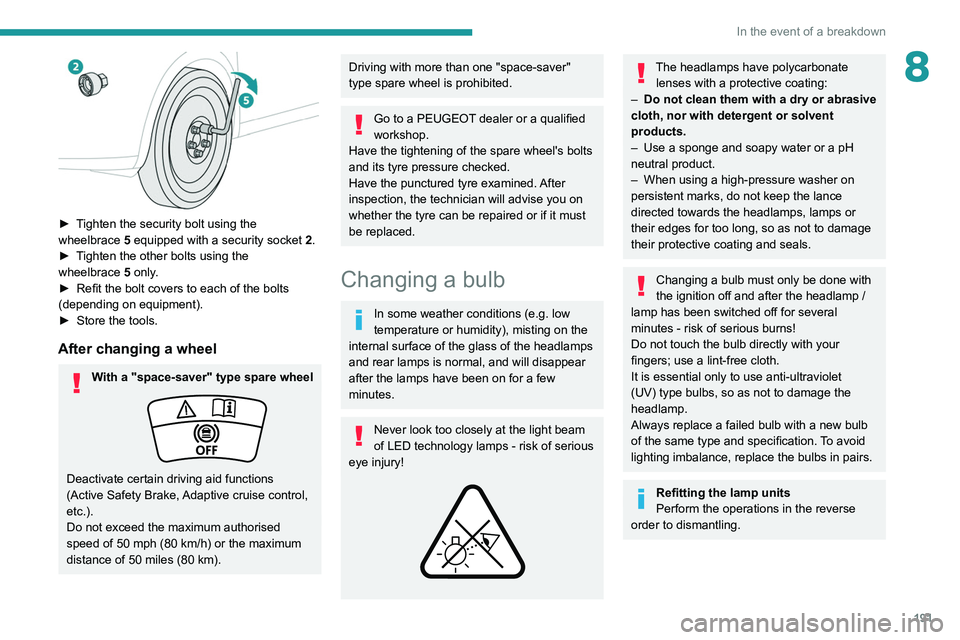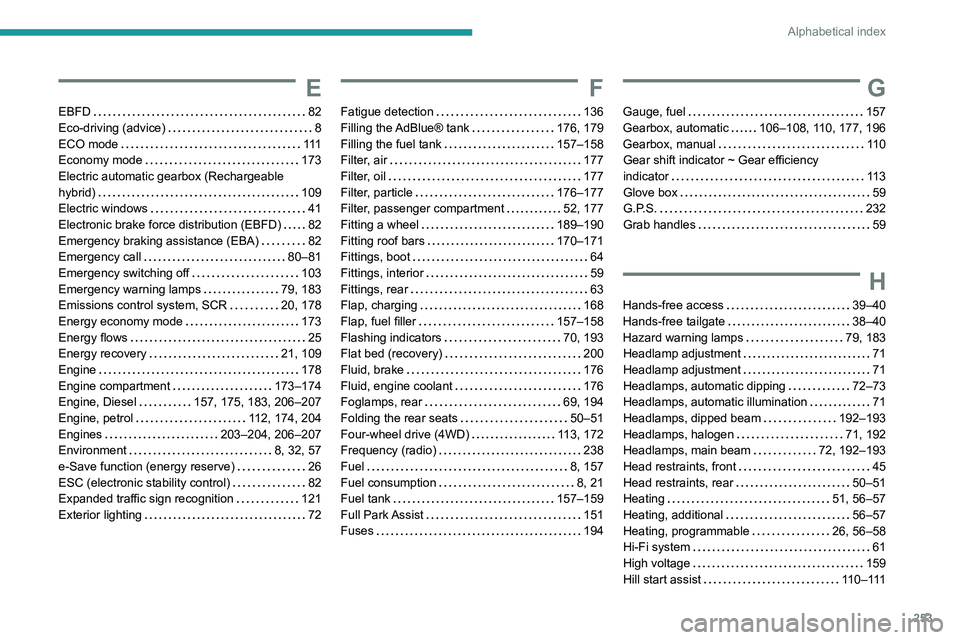2021 PEUGEOT 508 low beam
[x] Cancel search: low beamPage 174 of 292

172
Practical information
Sunroof
Do not operate the sunroof when using
roof bars - risk of major damage!
Bicycle / accessory carrier
Do not attach an accessory carrier to the
tailgate.
Very cold climate screen
(Depending on country of sale)
This removable device prevents the
accumulation of snow around the radiator
cooling fan.
In case of difficulty with installation/
removal
Contact a PEUGEOT dealer or a qualified
workshop.
Before any operation, ensure that the
engine is off and the cooling fan has
stopped.
It is essential to remove them when:
– the outside temperature exceeds
10°C.
–
recovery is in progress.
–
the speed is above 75 mph (120
km/h).
Snow chains
In wintry conditions, snow chains improve
traction as well as the behaviour of the vehicle
when braking.
Snow chains must be fitted only to the
front wheels. They must never be fitted to
"space-saver" type spare wheels.
Observe the legislation in force in your
country relating to the use of snow
chains and maximum authorised speeds.
Only use chains that have been designed to be
fitted to the type of wheel on the vehicle:
Original tyre size Maximum link size 215/60 R16 9 mm
215/55 R17 9 mm
235/45 R18 Cannot be fitted with
chains
(with standard chains)
235/40 R19 Cannot be fitted with chains
(with standard chains)
245/35 R20 Cannot be fitted with
chains
(with standard chains)
For more information, contact a PEUGEOT
dealer or a qualified workshop.
Installation tips
► To fit the snow chains during a journey, stop
the vehicle on a flat surface at the side of the
road.
►
Apply the parking brake and position any
wheel chocks under the wheels to prevent
movement of the vehicle.
►
Fit the snow chains following the instructions
provided by the manufacturer
.
►
Move off gently and drive for a few moments,
without exceeding 31
mph (50 km/h).
►
Stop the vehicle and check that the snow
chains are correctly tightened.
It is strongly recommended that you
practise fitting the snow chains on a level
and dry surface before setting off.
Avoid driving with snow chains on roads that have been cleared of snow to avoid
damaging the vehicle's tyres and the road
surface. If the vehicle is fitted with alloy
wheels, check that no part of the chain or its
fixings is in contact with the wheel rim.
Rechargeable hybrid vehicles
The use of snow chains is only
authorised on the front wheels.
The driving mode selector must be on the
4WD position (depending on version).
Energy economy mode
This system manages the duration of use of
certain functions, in order to conserve a sufficient
level of charge in the battery with the ignition off.
After switching off the engine and for a maximum
cumulative period of around 30 minutes, you can
continue to use functions such as the audio and
telematics system, dipped beam headlamps or
courtesy lamps.
Selecting the mode
A confirmation message is displayed when
energy economy mode is entered, and the active
functions are placed on standby.
If a telephone call is in progress at the
time, it will be maintained for around 10
minutes via the audio system’s hands-free
system.
Exiting the mode
These functions are automatically reactivated the
next time the vehicle is used.
To restore the use of these functions
immediately, start the engine and let it run:
– For less than 10 minutes, to use the
equipment for approximately 5 minutes.
– For more than 10 minutes, to use the
equipment for approximately 30 minutes.
Let the engine run for the specified duration to
ensure that the battery charge is sufficient.
Page 193 of 292

191
In the event of a breakdown
8
► Tighten the security bolt using the
wheelbrace 5 equipped with a security socket 2 .
►
T
ighten the other bolts using the
wheelbrace
5
only.
►
Refit the bolt covers to each of the bolts
(depending on equipment).
►
Store the tools.
After changing a wheel
With a "space-saver" type spare wheel
Deactivate certain driving aid functions
(Active Safety Brake, Adaptive cruise control,
etc.).
Do not exceed the maximum authorised
speed of 50 mph (80 km/h) or the maximum
distance of 50 miles (80 km).
Driving with more than one "space-saver"
type spare wheel is prohibited.
Go to a PEUGEOT dealer or a qualified
workshop.
Have the tightening of the spare wheel's bolts
and its tyre pressure checked.
Have the punctured tyre examined. After
inspection, the technician will advise you on
whether the tyre can be repaired or if it must
be replaced.
Changing a bulb
In some weather conditions (e.g. low
temperature or humidity), misting on the
internal surface of the glass of the headlamps
and rear lamps is normal, and will disappear
after the lamps have been on for a few
minutes.
Never look too closely at the light beam
of LED technology lamps - risk of serious
eye injury!
The headlamps have polycarbonate lenses with a protective coating:
–
Do not clean them with a dry or abrasive
cloth, nor with detergent or solvent
products.
–
Use a sponge and soapy water or a pH
neutral product.
–
When using a high-pressure washer on
persistent marks, do not keep the lance
directed towards the headlamps, lamps or
their edges for too long, so as not to damage
their protective coating and seals.
Changing a bulb must only be done with
the ignition off and after the headlamp /
lamp has been switched off for several
minutes - risk of serious burns!
Do not touch the bulb directly with your
fingers; use a lint-free cloth.
It is essential only to use anti-ultraviolet
(UV) type bulbs, so as not to damage the
headlamp.
Always replace a failed bulb with a new bulb
of the same type and specification. To avoid
lighting imbalance, replace the bulbs in pairs.
Refitting the lamp units
Perform the operations in the reverse
order to dismantling.
Page 255 of 292

253
Alphabetical index
E
EBFD 82
Eco-driving (advice)
8
ECO mode
111
Economy mode
173
Electric automatic gearbox (Rechargeable
hybrid)
109
Electric windows
41
Electronic brake force distribution (EBFD)
82
Emergency braking assistance (EBA)
82
Emergency call
80–81
Emergency switching off
103
Emergency warning lamps
79, 183
Emissions control system, SCR
20, 178
Energy economy mode
173
Energy flows
25
Energy recovery
21, 109
Engine
178
Engine compartment
173–174
Engine, Diesel
157, 175, 183, 206–207
Engine, petrol
112, 174, 204
Engines
203–204, 206–207
Environment
8, 32, 57
e-Save function (energy reserve)
26
ESC (electronic stability control)
82
Expanded traffic sign recognition
121
Exterior lighting
72
F
Fatigue detection 136
Filling the AdBlue® tank
176, 179
Filling the fuel tank
157–158
Filter, air
177
Filter, oil
177
Filter, particle
176–177
Filter, passenger compartment
52, 177
Fitting a wheel
189–190
Fitting roof bars
170–171
Fittings, boot
64
Fittings, interior
59
Fittings, rear
63
Flap, charging
168
Flap, fuel filler
157–158
Flashing indicators
70, 193
Flat bed (recovery)
200
Fluid, brake
176
Fluid, engine coolant
176
Foglamps, rear
69, 194
Folding the rear seats
50–51
Four-wheel drive (4WD)
113, 172
Frequency (radio)
238
Fuel
8, 157
Fuel consumption
8, 21
Fuel tank
157–159
Full Park Assist
151
Fuses
194
G
Gauge, fuel 157
Gearbox, automatic
106–108, 110, 177, 196
Gearbox, manual
11 0
Gear shift indicator ~ Gear efficiency
indicator
11 3
Glove box
59
G.P.S.
232
Grab handles
59
H
Hands-free access 39–40
Hands-free tailgate
38–40
Hazard warning lamps
79, 183
Headlamp adjustment
71
Headlamp adjustment
71
Headlamps, automatic dipping
72–73
Headlamps, automatic illumination
71
Headlamps, dipped beam
192–193
Headlamps, halogen
71, 192
Headlamps, main beam
72, 192–193
Head restraints, front
45
Head restraints, rear
50–51
Heating
51, 56–57
Heating, additional
56–57
Heating, programmable
26, 56–58
Hi-Fi system
61
High voltage
159
Hill start assist
11 0 – 111